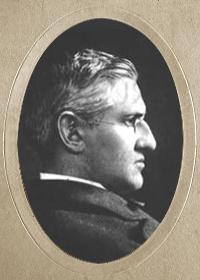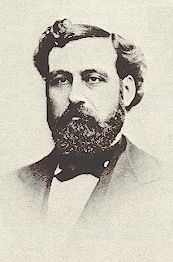
哦,我魂,可無恐
|
(一) 平安如水流,正一路跟隨我; 憂慮如怒濤,勢洶湧;任何的遭遇,你已教我能說: 哦,我魂,當安息,無所恐! ﹝副歌﹞哦,我魂,可無恐!哦,我魂,可安樂、可無恐! (二) 撒但雖肆虐,試煉雖如烈火, 我心仍應當有把握;因主明瞭我是何等的軟弱, 祂已為我流血成工作。 (三) 我罪,哦,這是何等榮耀思想, 我罪,非局部,乃攏總,全釘祂十架,卻不壓我身上, 哦,我魂,要稱頌,要稱頌! (四) 活著是基督,是基督在執政, 即便那死河起波瀾,我也無苦痛,因雖死猶如生, 祂對我正低聲賜平安。 (五) 我主、我救主,我等候你再臨, 我眼是望你,不望墓;號筒要吹響!是我主的聲音! 何榮耀的盼望,何有福! |
詩人介紹
這一首詩歌(聖徒詩歌494)是史派福(Horatio G. Spafford 1828-1888)所寫的。在他年輕時,他就在芝加哥開辦了一間很成功的律師事務所。雖然名利雙收,他卻對教會的活動一直保持熱忱的支持。平時熱心參與福音事工,和佈道家慕迪是至交。當年一位很著名的福音派音樂家史戴賓(George Stebbins)如此形容史派福:「他是一位絕頂聰明而又細緻的人,他也非常屬靈,並且認真勤讀聖經!」在1871 年的芝加哥大火發生的前幾個月,史派福在密西根湖畔大量投資在房地產上;因此,他的投資也都毀於這次的大災難裡了,而不久前他的獨子又猝死!因為他希望讓他的太太與四個女兒能好好地休息,而且他也希望能幫助慕迪與山奇(Moody and Sankey)他們在英國的培靈佈道活動,他就安排他的家人在1873年11月來一趟歐洲之旅。
他在出發前一刻,因為業務上的需要而必須留下來,於是他只好送他太太與四個女兒依原訂的船期,登上汽船(S.S. Ville du Harve)前往歐洲;而他自己則預計在幾天之後,處理完相關業務,再前往歐洲與妻女會合。但是,在11月22日,這一艘由美國前往歐洲的船,被另一艘英國輪船(Lochearn)撞上,在短短的12分鐘裡就沉沒了!幾天之後,海難的生還者終於在威爾斯的卡迪夫(Cardiff, Wales)登岸;史派福太太給她先生發了一封電報:「僅我生還(Saved alone)」!
史派福是位認識神的人接到電報立即鑲框懸掛,以誌記念,並謝神恩。他告訴一位摯友說:「願神的旨意成全就是了。」他又說:「在沉痛的犧牲中,我樂意把萬事交託主。」因為這是他第二次的試煉。芝加哥的大火剛剛把他的財產燒光,這滅門之禍又接踵而來。他於是立即搭船赴歐,急於與太太相會。同年十二月間,船長請他到船長室告訴他:「我相信已經駛過維利號沉沒的地方了。」當晚無法入睡。但信心遂即勝過頹喪。傷痛之餘,就在中大西洋作這五節的歌詞。夫妻會面幾星期之後,斯帕福夫人說:「我並未損失我的女兒,只是暫時的離別。」一位朋友也在遭受遠不如斯帕福沉重的苦難;他向人表示:「假如她感覺如此,我將毫無怨言。」
史派福隨即乘船前去與他摯愛的妻子會合,當他搭船來到他四個女兒溺斃的海域附近時,椎心的哀痛如滾滾波濤洶湧而來,但神安慰他,使他心靈得安寧。他寫下了這一段描述他自己內心深沉悲慟的歌詞:「憂慮卻如怒濤橫湧!(When sorrows like sea billows roll ……)」史派福寫的這首詩的前二節,即當時的情景。然而在第四與五節,他並沒有停留在人生的悲哀與苦難的主題上,反而是著重於「基督的救贖大功 (第四節)」和「盼望基督第二次榮耀的再來(第五節)」。常人在經歷這麼多變故後,很難聲稱「哦,我魂,可無恐」。惟有基督徒信靠仰望主,才能得力,在苦難中,屹立不移。
1881年 史派福(多年的宿願終於得償,他和妻子帶了二個幼女與一夥朋友,離開芝加哥,遷居耶路撒冷聖地。 他們設立了「美僑會館」,照顧貧困的人和病者,又創辦「施彼福兒童醫院」。 八年後他去世,但這些慈善工作一直有人繼續。 多年後他的外孫女繼承祖志,在耶路撒冷成立「施彼福兒童中心」。
這首詩的歌譜由布立斯(Philip Paul Bliss)所作。斯帕福和布立斯為慕迪和桑基佈道團多年的同工。布立斯知曉史派福的經歷和詩後,深受感動,旋即為這詩譜曲。布立斯作好此曲之後,於1876年11月最後的星期五,有一千多位牧師在芝加哥的「再見面會堂」(Farewell Hall)聚會,布立斯獨唱介紹本詩。不料一個月之後,布立斯本人和他的太太,搭乘火車返回芝加哥途中,列車壓垮鐵橋,他們兩位與將近百名乘客當場死亡。
詩歌感想
這是一首偉大的詩歌是因為詩人偉大。從這首詩歌你能看見,這位詩人是一生經過多少懮慮,煎熬,仇敵凶猛的攻擊,沉重的十架火煉,靠著主的恩典他都得胜過來了。現在他已得著了丰盛的屬靈生命和經歷,主也賜他那樣美好的恩賜和技巧,能寫出這樣偉大的詩歌使后代千万圣徒從這首詩得著屬靈的幫助。
在第一節開始他就寫“平安如水流,正一路跟隨我”這是一句使人何等羡慕的福份,英文是“
attendeth my way”,在我的道路中跟隨我。他的道路是什么的道路,是什么樣環境呢?第二句他立刻接著說“懮慮如怒濤勢橫涌”這是最痛苦最可怕的環境,是在這樣的環境中“平安如水流正在我的道路中跟隨我”,如何可能呢?第三句更寶貴了,“任何的遭遇,你已教我能說:我的魂,當安息,無所恐!”這是一個經過主千錘百煉的生命,已再無一個力量能搖動他的平安,他的安息,然后是副歌“哦,我魂,可無恐!哦,我魂,可安息,可無恐!”這是何等在生命中的夸胜。第二節一開始,他繼續說到更大的試煉,更可怕的仇敵的攻擊。“撒但雖肆虐,試煉雖如烈火”,接著他那樣雄壯有力的對自己說“我心,你應當有把握”,我的把握在哪里呢?下面寫得好極了。“因主明了我是何等的軟弱,已流出他寶血為著我”,把握是在主完全明了我是何等軟弱,所以已為我流出他的寶血。把握是在于我的軟弱,主完全明白,所以已為我流出他寶血,把握是在于寶血的大能和寶血的得胜。
第三節,他站在他的軟弱上來頌揚主的救贖,救贖是神最偉大的思想,最偉大的作為。“我罪,哦,這是何等榮耀思想,我罪,非局部,是一切釘在他十架,不壓在我身上,哦,我魂,當歌頌,當稱謝,”英文是“
Praise the Lord,Praise the Lord,O my Soul.”第四節把詩帶到最高峰:活著是基督,是主基督執政,即使約但河起波瀾,我也無痛苦,雖經死猶如生,仍听他低聲說:“你平安”。
第五節歸結在我們的榮耀盼望:哦,主,我救主,我等候你再臨,我眼是望天,不望墓;哦,號筒吹響,哦,我主的聲音!哦,何等的盼望,何等福! 以我們榮耀的盼望作結束,但它結束得何等榮耀!何等美好!摘自詩人与詩歌(三)
詩歌感想
「神所賜出人意外的平安,必在基督耶穌裏,保守你們的心懷意念。」【腓四7】
「平安」原文字義(eirene)是指一種內在的安寧。「保守」原文字義(phrourein)是一種軍事用語,描寫衛兵站崗守衛的情形。舊約中描寫平安是指神使一切仇敵臣服,彰顯祂全權的治理後,立刻臨到的福氣(shalom;參賽三十二17)。按新約,平安來自與神和好(羅五1),這是透過主耶穌基督在十架上成就了和平(西一20)。神所賜的平安,乃是神的平安,也就是神自己。保羅用軍事比喻來形容神平安的作為。神的平安能像軍兵把守城池那樣的保守我們的心,使一切的憂愁掛慮無法越雷池一步。
在我們的一生中,難免會遇上風浪,諸多打擊都可能無情、而且無法預期地發生!我們應該如何去面對呢?我們可以從史派福所寫的這一首詩歌「哦,我魂,可無恐!」裡,學習倚靠神,不論環境順逆,確信神的平安足能保守我們的心。我們若能學習不焦慮,不靠自己;在一切行事上讓基督的平安作主宰,作裁判【西三15】;並以保持這種平安作為人際間行事的準則。這樣,在一切情況和境遇中我們就都能處之泰然,我們的心靈就會享受無比的安寧,自然口也能唱出「哦,我魂,可安樂、可無恐!」
It Is Well with My Soul
When peace, like a river, attendeth my way, When sorrows like sea
billows roll;
Whatever my lot, Thou has taught me to say, It is well, it is well, with
my soul.
Refrain
It is well, with my soul, It is well, with my soul, It is well, it
is well, with my soul.
Though Satan should buffet, though
trials should come, Let this blest assurance control,
That Christ has regarded my helpless estate, And hath shed His own blood
for my soul.
Refrain
My sin, oh, the bliss of this glorious
thought! My sin, not in part but the whole,
Is nailed to the cross, and I bear it no more, Praise the Lord, praise
the Lord, O my soul!
Refrain
And Lord, haste the day when my faith shall be sight, The clouds be
rolled back as a scroll;
The trump shall resound, and the Lord shall descend, Even so, it is well
with my soul.
Refrain
Horatio G. Spafford was a successful businessman in Chicago in the late 1860s, heavily invested in real estate along the shores of Lake Michigan. The disastrous Chicago fire of 1871 wiped out his holdings. He immediately worked to rebuild the city and assist the many that were left homeless.
In 1873 he arranged to take his family to Europe. He was close to D.L. Moody and Ira Sankey and planned to attend their evangelistic meetings in England, then take a vacation. At the last minute, urgent business kept him home, but he sent his wife and four daughters ahead on the S.S. Ville du Havre, planning to soon follow.
The night of November 22, 1873, the Ville du Havre, was struck by an English iron sailing vessel, the Lochearn. The ship sank in 12 minutes. Of the 273 people on board, only 47 of them survived. Mrs. Spafford was found nearly unconscious, clinging to a piece of the wreckage. Their four daughters did not survive. When she reached Cardiff, Wales, she cabled home, "Saved alone, what shall I do?"
Grief-stricken, Horatio immediately started to Europe to join his wife. En route, the captain pointed out the place where he believed the Ville du Havre had gone down. Returning to his cabin, he wrote, "It is well; the will of God be done." He later wrote the hymn "It Is Well with My Soul", based on these words.
Although Spafford in his hymn tells of the comfort that God gives, no matter the circumstance, he does not dwell on tragedy. In the third stanza he directs our attention on Christ’s redemptive work on the cross, and in stanza four, anticipates His Second Coming. As we through faith understand these things, we too can say, "It is well with my soul."

Birth: October 29, 1828, North Troy, New York
Death: October 16, 1888, Jerusalem, Israel
Horatio G. Spafford, the lyricist of "It Is Well with My Soul", was born in 1928 in New York. He married Anna Larssen, fourteen years his junior in 1861. He was a successful lawyer in Chicago. He was closely associated with Dwight L. Moody and other evangelists of the time. He was an active member of the Fullerton Presbyterian Church, which he helped build. George Stebbins, a noted gospel musician, described him as a "man of unusual intelligence and refinement, deeply spiritual and a devoted student of the Scriptures."
Spafford, in order to assist Moody and Ira Sankey in their evangelical meetings in Great Britain, booked passage on the S.S. Ville du Havre for family. At the last minute, he was unable to leave, but sent his family on ahead, planning to soon follow. At sea the ship was struck by another ship and sank. He and his wife lost their four daughters at sea.
In 1881 he, his wife, and the two daughters born to them after the shipwreck, moved to Jerusalem, where he helped to found a group call the American Colony. The mission of the group was to serve the sick and destitute. Nobel Prize winning Swedish novelist Selma Lagerlof later wrote about this colony in Jerusalem. Horatio and Anna Spafford's daughter, Bertha Spafford Vesper also has written a book about the Colony, Our Jerusalem (1950). The American Colony still exists in Jerusalem. You may learn more about it in the Library of Congress Exhibition at http://www.loc.gov/exhibits/americancolony/amcolony-family.html or through Mrs. Vesper's work at http://chass.colostate-pueblo.edu/history/seminar/vester/paper.htm.

Birth: July 9, 1838, Clearfield County, Pennsylvania
Death: December 29, 1876, Ashtabula, Ohio
Philip Bliss was born in 1838 to a dedicated Christian family living in Pennsylvania's mountains. His first memories of his father, Isaac, were of daily family prayers. His father also loved music and ingrained a love of singing in Philip.
Bliss had little schooling, mostly his father's singing and his mother's teaching. At age eleven, he left home to make a living for himself. For five years he worked in logging and lumber camps and sawmills. He made a public confession of Christ as his savior at age twelve, although he never knew a time when he did not love Christ.
In 1851, Bliss became assistant cook in a lumber camp and was later promoted to log cutter and then sawmill worker. Between these jobs he attended school. He was undecided as to what vocation he wanted, so he prepared himself for whatever might come. Along with this, he spent some money on his musical education and began to participate in Methodist camp meetings and revival services.
At age seventeen, Bliss went to Bradford City, Pennsylvania and completed his requirements for teaching credentials. He obtained a teaching position at Hartsville, New York. In 1857 he met J.G. Towner, who conducted a vocal school in Pennsylvania.
Towner recognized Bliss' unusually fine singing voice and offered to provide formal voice training. He also made it possible for Bliss to go to a musical convention, where he met William B. Bradbury, a noted composer of sacred music. It was Bradbury who convinced Bliss to surrender his talents to the Lord.
Bliss eventually met and married Lucy Young, a poet who also came from a musical family and encouraged his musical talents. Bliss took music pupils to supplement his income and later became an itinerant music teacher, traveling with a $20 melodeon and an ancient horse.
Though he enjoyed teaching music, Bliss recognized his limitations and longed to study under an accomplished musician. His wife's grandmother provided him with $30 to attend the Normal Academy of Music of New York, after which he became a professional music teacher in earnest. He also began to compose music at this time.
One night, while passing a revival meeting where D. L. Moody was preaching, Bliss went in to listen. As the singing was weak, his voice stood out. Moody sought him out and asked him to come to his Sunday evening meetings. He urged him to become a singing evangelist.
In 1873 Bliss joined his friend Major Whittle at a revival. The Holy Spirit filled the hall and many souls were brought to Christ that night. The following afternoon, as they met for prayer, Bliss surrendered his life to Jesus Christ anew, giving up his secular song writing, his business position, and his church work so that he could devote full time to singing of sacred music in evangelism.
Using his talents for the Lord, Bliss wrote many hymns and other songs. He published "Gospel Songs," "Gospel Hymns and Sacred Songs" in 1875, and was co-editor of "Gospel Hymns No. 2" a year later. He labored for the love of God, declining copyright benefits. The royalties, an amount of about $60,000, were distributed to worthy charities instead.
In December of 1876, Bliss died in a train wreck near Ashtabula, Ohio. Though he had survived the wreck, he went back to rescue his beloved wife and they both perished in the flames.